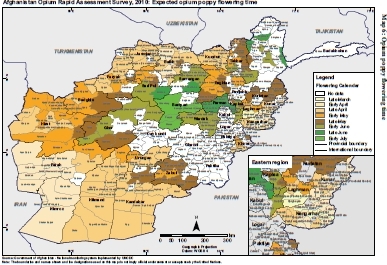After declining for the last two years, opium cultivation in Afghanistan will remain close to 2009 levels, the UN Office on Drugs and Crime (UNODC) said in a report Wednesday. The report, the agency's annual winter opium survey is based on reports from farming villages about whether they planted opium last fall.

Afghan opium production peaked at 8,200 tons in 2007 and was estimated at 6,900 tons last year. This year's production should be similar, although the UNODC held out the hope that drought could reduce production even if the same amount of land is planted. Global demand for illicit opium is estimated at about 5,000 tons a year.
"Overall, the cultivation of opium in Afghanistan is likely to remain stable in 2010 but the number of poppy-free provinces may decrease," from 20 to 17, the report said. "However, if timely poppy eradication measures are implemented and/or drought conditions prevail, a total of 25 provinces -- an increase of five compared to 2009 -- could be poppy-free in 2010."
The report surveyed 536 Afghan villages and found that 35% said they had planted opium for the 2010 harvest. Farmers cited better prices for opium than for other crops. While the price of dry opium has declined by 6% from last year, and the price of raw opium by 13%, prices for competing crops have declined every more severely. The farm gate price for corn is down 38% and wheat is down 43%.
"None of Afghanistan's licit agricultural products can currently match the gross income per hectare from opium, although the difference is not as high as it used to be some years ago," the report said.
Villages that reported opium cultivation tended to be villages that were outside effective government control. Nearly 80% of villages with poor security conditions grew poppy, while only 7% of villages with "very good security" did.
"This is further proof of the overlap between high insecurity and high cultivation," UNODC chief Antonio Maria Costa said in a statement. "The message is clear: in order to further reduce the biggest source of the world's deadliest drug, there must be better security, development and governance in Afghanistan."
Southern Helmand province produces more than half of all Afghan opium. US and NATO forces backed by the Afghan military are preparing a major offensive aimed at breaking the back of the opium trade there. It could be underway by the time you read these words.
[Ed: It would have been more accurate for Costa to say there is overlap between high insecurity and where cultivation ends up being located. Someone is going to grow to supply the demand, if not in the current locations, then in other parts of Afghanistan or in other countries. If NATO's hope is to deny its profits to the Taliban by shifting it elsewhere -- to parts of Afghanistan not controlled by the Taliban, or even to other countries -- perhaps they can accomplish that; that's a military question. If they are claiming they will reduce surplus growing, perhaps they can even accomplish that. But supply will not drop below the level needed to supply the global demand, at least not for longer than the stockpiles that presumably exist from prior years' surpluses can hold out.]
This work by StoptheDrugWar.org is licensed under Creative Commons Attribution-ShareAlike 4.0 International
Add new comment